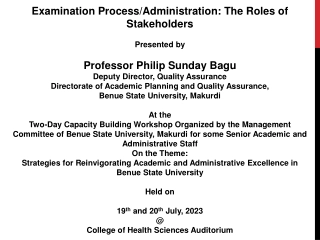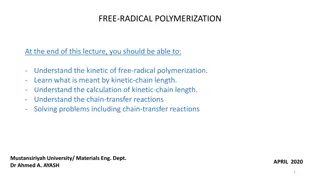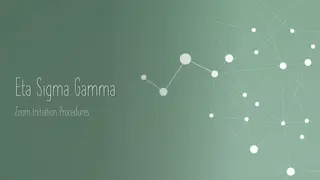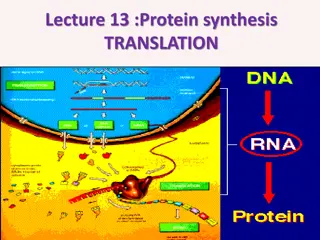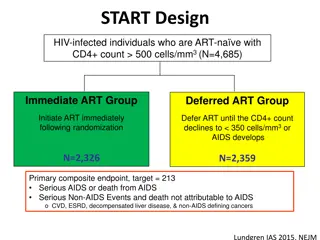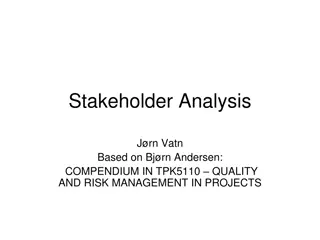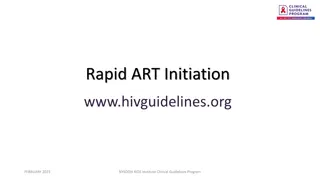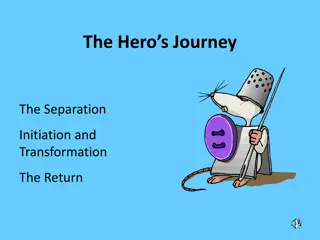Key Stakeholders and Project Initiation
In this content, you will learn about identifying key stakeholders in project management and the process of project initiation. Key concepts include project goals, scope, stakeholders, and project launch phase. Understanding these aspects is crucial for successful project execution and decision-making.
Uploaded on Feb 21, 2025 | 0 Views
Download Presentation

Please find below an Image/Link to download the presentation.
The content on the website is provided AS IS for your information and personal use only. It may not be sold, licensed, or shared on other websites without obtaining consent from the author.If you encounter any issues during the download, it is possible that the publisher has removed the file from their server.
You are allowed to download the files provided on this website for personal or commercial use, subject to the condition that they are used lawfully. All files are the property of their respective owners.
The content on the website is provided AS IS for your information and personal use only. It may not be sold, licensed, or shared on other websites without obtaining consent from the author.
E N D
Presentation Transcript
ISNE101 Dr. Ken Cosh Week 13
Review SDLC & Data
This Week People! Who are the key stakeholders?
Project Blast Off Launch Kick Off Initiation Where we get the project started.
Project Blast Off Often involves getting together a group of the key project stakeholders, to discuss and define the project. The Loftier the Building, the deeper the foundation must be laid Kempis At the end of Blast Off, the decision needs to be made, whether to Blast Off or not.
Blast Off Deliverables Can Include; Project Purpose (Goals) Scope Stakeholders Constraints Names Relevant Facts and Assumptions Estimated Cost Risks I.e. A Feasibility Study used to make the Go / No Go Decision.
Goals, Scope and Stakeholders Assumptions The Project is going to build a product (could be software, hardware, both). The product is going to be useful, in helping someone with their work. To understand what the product should do, we need to understand the work, and to do that we need to speak to Stakeholders in that work.
Goals A short statement explaining what the product is intended to do, and what advantages it will bring to the business. This is the justification for the project.
Scope Once we have a goal, we can set the scope of the project. The scope is the business area affected by the product. Where does the product fit, and what other products does it interrelate with? This defines what work we will study, and what work we will NOT study.
Stakeholders Once we know the Scope, we can identify Stakeholders. Stakeholders are people who have some stake in the success of the product. (Or have an effect on the product). Employees / Employers Government Customers Suppliers
Goals Once Stakeholders are identified, the goals of the project may change significantly! If the goals of the project change, then surely the scope of the project will change! If the scope of the project changes, then surely the stakeholders will change! And if the Stakeholders change then . Somebody stop this madness!!!
Goals, Scope and Stakeholders Scope Goals Stakeholders
Project Suppose I wanted to build an Automated Marking System My goal is to use a computer to mark your course projects. The scope therefore is the marking part of my work. With links to teaching, grading, registration, feedback The Stakeholders are obviously Me , and well, probably Aj. Santi, and I guess you students. As soon as you are stakeholders then your goals will be included in the project perhaps you want feedback automatically? Which clearly changes the goals and then scope of the project!
When will this end? Well that is the job of the Blast Off. We can iterate around the circle as many times as needed, until a consensus of the project is reached. So, this is why senior stakeholders are needed in the Project Blast Off. And in my marking system, you probably aren t invited! ;)
Onion Diagram (Alexander) The Wider Environment (Socio-Technical) The Containing Business (Socio-Technical) Operational Work Area (Socio-Technical) Product Core Team
Onion Diagram Intended Product Unsurprisingly is at the centre of the onion! Operational Work Area This contains stakeholders who have direct interaction with the product. The users. The Containing Business Stakeholders who will benefit from the system in someway, although they don t directly use it. The Wider Environment Other Stakeholders who have an influence on the product. The Core Team Span all rings of the onion!
Important Stakeholders The most important stakeholders include; The Client The Customer The Users Note that these inhabit the inner rings of the onion
The Client Show me the money! People are going to work on this project. Who is going to pay for their time? Somebody has to pay for it, and that person is the Client. As the client is probably paying for your time, it s probably a good idea to keep them happy!
The Customer Customers buy the product once its developed. (Note the difference between client and customer). Customers might walk out of a shop with your product in the future. You may know the names of your customers in advance, or you may not Either way you need to understand your potential customers very well. You need at least a representative from your potential customers to be part of your stakeholders.
The Users Those who are going to operate your product. Perhaps people who work for your client? Perhaps the same people as your customers? It s important to get to know your users.
The Users There are many different types of user, so getting to know them is difficult! Experience Level? Intellectual Capability? Linguistic Skills? Disabilities? There are many usability issues, which I am sure you will encounter in other courses! Also remember that people other than the intended users may end up using the product. So identifying superfluous users could be beneficial!
Other Stakeholders Consultants Management Experts (Domain) Inspectors Market Forces Legal Department Negative Stakeholders Industry Standard Setters Public Opinion Government Special Interest Groups Technical Experts Cultural Experts Adjacent Systems
People: Stakeholders Executives: Defines business issues Project (technical) managers: Plan, motivate, organize, and control the practitioners Practitioners: Deliver the technical skills Customers: Specify the requirements for the software End-Users: Interact with the software once it is released Sponsors: Provide funds and evaluate overall success
People: Project People Project manager is a person who thinks nine women can deliver a baby in one month Developer is a person who thinks it will take 18 months to deliver a baby Client is the one who doesn t know why he wants a baby Marketing manager is a person who thinks he can deliver a baby even if no man and woman are available Resource optimization team thinks they don t need a man or woman; they ll produce a child with zero resources Tester is a person who always tells his wife that this is not the right baby HR manager is a person who thinks that a donkey can deliver a human baby in given 9 months Source: a random Facebook guy
People: Essential Skills for Project Manager People skills Leadership Listening Integrity, ethical behaviour, consistent Strong at building trust Verbal communication Strong at building teams Conflict resolution, conflict management Critical thinking, problem solving Understands, balances priorities
People: Effective VS Ineffective Project Managers Effective Project Managers Ineffective Project Managers Lead by example Set bad examples Are visionaries Are not self-assured Are technically competent Lack technical expertise Are decisive Avoid or delay making decisions Are good communicators Are poor communicators Are good motivators Are poor motivators
People: Leader VS Boss Leader Boss Coaches the team Drive the team Depends upon goodwill Depends upon authority Inspires enthusiasms Inspire fear Says We Says I Sets the pace Assigns the tasks Begins on time Says Get here on time Fixes the breakdown Fixes the blame for the breakdown Shows how it is done Know how it is done Makes it a game Makes work boring Says Go! Says Let s go!
People: Belbins Key Team Roles The Company Worker (Implementer) IM Strong sense of organizational duty and efforts The Chairman (Coordinator) CO Calm, strong and realistic The Plant PL Clever and innovative The Resource Investigator RI Ideas gathering and energetic The Shaper SH Leader, challenger, high need for achievement
People: Belbins Key Team Roles (Contd.) The Monitor-Evaluator ME Serious, pride, critical thinker The Team Worker TW Social, trusting and sensitive The Completer-Finisher CF Finisher, perfectionist Specialist SP Individual, specialized in subjects
Belbin Test Result Implementer Coordinator Shaper Planter Resource Investigator Monitor Evaluator Team Worker Completer Finisher Specialist



